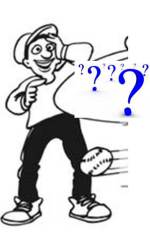Obstruction and Interference
What are some good tips for beginners?
Understanding how to rule on the many possibilities is an acquired skill learned in the heat of battle. In the meantime, here are two tips that will help you be better prepared and deal with uncertainty.
What can I do to anticipate violations?
What should I do if I’m unsure about the right call?
Watch fielders’ positioning before the next pitch to anticipate potential violations
- Obstruction and interference are easier to see and call when you anticipate a violation before it happens. As the pitcher prepares to throw the next pitch, look at where the fielders are standing.
- If a fielder is standing in the base path, especially when close to a base occupied by a runner, the chance of runner interference or fielder obstruction on a batted ball is high. The chance of fielder obstruction on an attempted steal and throw from the catcher is high.
Examples:
| The Play | Your Call |
| Runner from first base (R1) runs into the first baseman who attempted to make a play on a batted ball to his area of the field. | R1 out for interference. |
| R1 is forced to go around the first baseman on a batted ball to the shortstop and in so doing, is late (and out) at 2nd base. | R1 safe on the obstruction at first base. |
| R1 has to run around the first baseman on an attempted steal. | R1 safe on obstruction if the catcher threw him out at second. |
- Younger players will often repeat the same positioning mistakes during a game until they learn from having a penalty called on them. Look for other fielder tendencies like standing in front of or on the bases for potential obstruction.
Dealing with uncertainty – let your crew decide on the call or “let it go”
- If you think a violation of some sort occurred but are unsure about what call to make, take one of two options:
1) Let all play finish and when the runners have settled and the ball is under control by an infielder, call “Time!” Meet with your umpire crew to decide what (if any), call to make.
- This is not ideal with dead ball violations (obstruction A and interference) because it’s harder to recall who was where at the time of the violation. But much better than killing a play in process if you’re not sure (and later wrong!)
2) Wait a moment after the play ends. If nobody complains or says anything, then it was either not of much consequence or completely missed. In that case, don’t say or do anything and just “let it go”.
- Another opportunity when you’re unsure: meet with your umpire crew to decide where to place runners after a violation.


